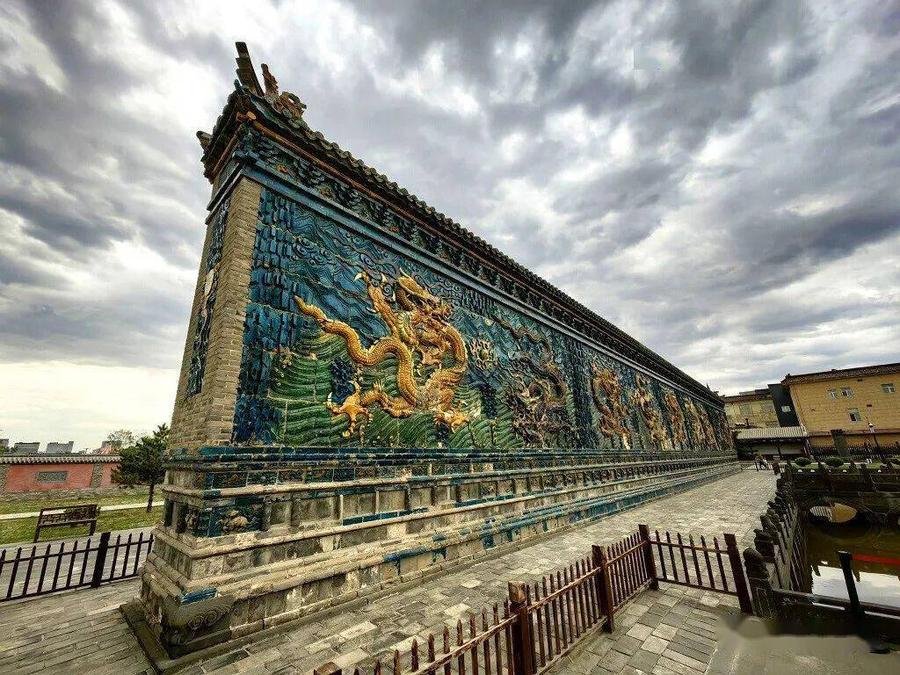The Nine Dragon Screen in Datong (大同九龙壁) is a stunning piece of architectural art, originally built as a decorative screen wall in front of the residence of Zhu Gui, the 13th son of Ming Emperor Zhu Yuanzhang. This single-sided glazed screen, facing south and positioned north, stands as a magnificent example of Ming Dynasty craftsmanship.
The Nine Dragon Screen measures 45.5 meters in length, 8 meters in height, and 2.02 meters in thickness. It comprises three main sections: the base, the wall body, and the roof. The entire structure is constructed using glazed tiles in a variety of colors including yellow, green, blue, purple, black, and white. The wall itself features 426 colorful glazed tile components, meticulously pieced together to create a vibrant and intricate façade.
The roof is designed with a single eave and five ridges, adorned with high-relief carvings of multi-layered petals, flowers, and dragons. It also includes an array of mythical beasts along the ridges and dragon-shaped ornaments on either end. The base, known as a Sumeru pedestal, consists of 15 layers of glazed bricks, standing 2.09 meters high.
Table of Contents
- Basic Information
- Location and Transportation
- Highlights of Nine Dragon Screen
- Other Attractions in Datong Ancient City
Basic Information
| Estimated Length of Tour | 30 minutes |
| Ticket Price | Free |
| Opening Hours | 8.00 – 18.00 (1st May – 30th September) 8.30 – 17.30 (1st October – 30th April) |
| Telephone Number | 0086-0352-2837988 |
Location and Transportation
The Nine Dragon Screen is located at 18 Dajie Street, in Datong Ancient City, Pingcheng District, Shanxi Province, China. To get there, you can take bus 38 or 59 and get off at Nine Dragon Screen Stop (九龙壁站, Jiulongbi).
Highlights of Nine Dragon Screen
Artistic Features

The wall’s highlight is the nine dragons, each rendered in high relief, creating a dynamic and vivid display. Below the dragons is a depiction of blue-green waves, while above them float blue and yellow clouds. The dragons are separated and connected by elements of clouds, waves, and cliffs, giving a sense of depth and movement. Above the wall are 62 sets of glazed dougong (interlocking wooden brackets), supporting the glazed tile roof.
The Sumeru pedestal features two layers of glazed mythical creatures. The upper layer showcases 41 groups of dragons playing with pearls, while the lower layer includes a variety of animals such as elephants, deer, lions, tigers, rabbits, dogs, goats, and flying horses. Each animal is crafted in high relief, set against a background, and separated by vertical stones, creating individual vignettes.
In front of the wall is a reflective pool measuring 34 meters in length and 0.8 meters in depth, surrounded by stone railings. The nine dragons reflect beautifully in this pool, adding to the visual splendor.
Design and Symbolism

The design of the nine dragons incorporates large curves, primarily using U-shaped, S-shaped, O-shaped, and 8-shaped forms. The central dragon, known as the sitting dragon, is positioned at the heart of the wall, aligning with the central axis of the prince’s residence and serving as the primary dragon.
On either side of the central dragon are two yellow descending dragons, facing left with their bodies turned away from each other. Next are two brown ascending dragons, also facing left. Following them are two purple descending dragons, again facing left with their bodies turned away. Finally, the two outermost brown ascending dragons face left but turn their heads away from each other. The first eight dragons are paired to create four scenes of two dragons playing with pearls, while the ninth dragon stands alone.








